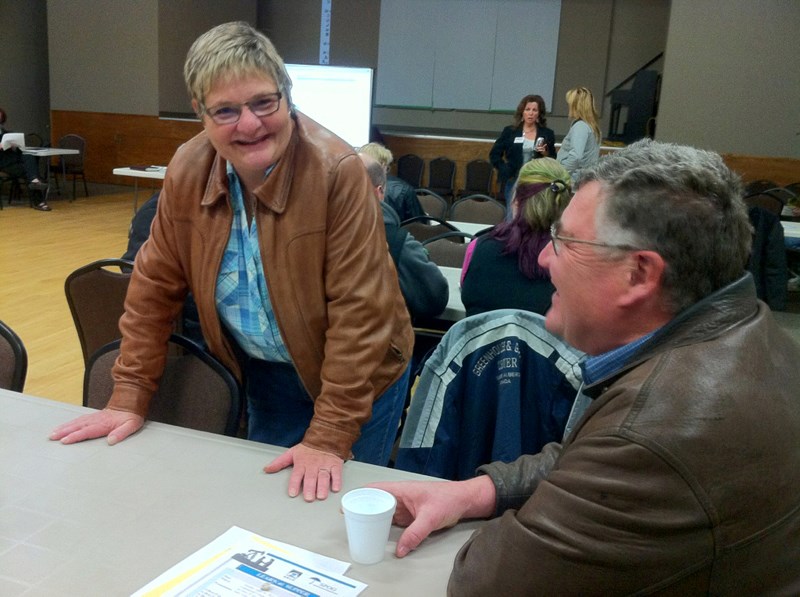Eighty-five people attended an open house at the Eagle Hill Community Centre on April 8 for the release of the Sundre Petroleum Operator's Group's new beneficial management practices for hydraulic fracturing.
Prepared over the past year with input from industry and community members, the management practices document has been developed to bridge the gap between government regulations and public expectations, said SPOG executive director Tracey McCrimmon.
“We are trying to find out what we can do to go above and beyond,” said McCrimmon. “We hope that we've addressed the concerns raised in our community and acknowledge that there are issues that continue to exist outside of SPOG's boundary but we remain committed and focused on addressing the needs and concerns of our stakeholders.”
SPOG is a collection of oil and gas companies with operations in the Sundre area. The organization also includes non-voting association members, including area municipalities and community groups.
Although the beneficial management practices are voluntary for SPOG members, they do set standards that companies are asked to follow, she said.
Hydraulic fracking is the use of high-pressure water and other fluids to create cracks in rock formations deep below the surface, which in turn, allows oil and gas to be more easily collected and moved to the surface.
The new SPOG best practices document deals with all aspects of hydraulic fracking, include fracturing fluid disclosure, water wells, groundwater and aquifers, water use, and information sharing with the community.
• Regarding fracturing fluid, the document states, in part: “Industry will provide, upon request, the disclosure of fracturing chemical additives on a well-by-well basis to residents and/or landowners consistent with the Canadian Association of Petroleum Producers' hydraulic fracturing operating practice” and “industry will commit to moving towards using greener products.”
• Regarding water testing, the document states, in part: “Industry will test as a minimum all water wells within a 250-metre radius. Industry will also commit to reviewing requests outside the 250-metre radius on a well-by-well basis if requested by a potentially impacted resident.”
• Regarding water use, the document states, in part: “Industry will make best efforts to share area beneficial practices such as pipelining of water, sharing of fracturing fluids and looking for ways to reduce water consumption through water recycling opportunities and technologies.”
• Regarding community communications, the document states, in part: “In the spirit of respect, transparency, and being a member of the neighbourhood, industry will consider landowners and residents who may be impacted by industry operations, from traffic, noise, visibility, light pollution, and communicate the company's plans with area stakeholders.
“The method of communication to parties outside of regulatory requirements is at the discretion and best judgment of the company. The company may communicate its plans by mail, telephone, public meeting, in person, or what is deemed appropriate.”
• Regarding the so-called footprint or long-term visibility of a fracking facility, the document states, in part: “Industry will collaboratively work with community members to address concerns regarding well site locations as appropriate. Companies may request SPOG's assistance in facilitating a proactive engagement process regarding their development plans.”
• Regarding lighting around facilities, the document states, in part: “Industry will work with neighbours to address potential concerns regarding light pollution, which may include the positioning of lights on site to reduce impacts on homes and roadways.”
During the April 8 meeting, McCrimmon said SPOG will be distributing the new best practices management document to many stakeholder groups, including other synergy groups in the province.
“We hope that communities outside of SPOG can benefit from the learnings of our process and start working collaboratively for positive outcomes in their areas,” said McCrimmon.
Among those in attendance at last week's meeting was Mountain View County councillor Paddy Munro, whose Division 6 includes Eagle Hill.
“These (best practices) are just general suggestions,” said Munro. “It's all just a friendly suggestion. If industry wants (to adhere to the suggestions) and it fits into their profit scheme they will make it happen. If it doesn't, maybe not.”
During the meeting Eagle Hill resident Ken Heck read an open letter about oil and gas development in the region. He called on industry to take measures to reduce the impact its activities have on the community at large.
Heck's letter states, in part: “We believe that you have the technology or you could have with use of progressive cavity pumps, submersible pumps, hydraulic lift pumps or something completely new if you would use a small portion of the ingenuity on the surface that you have shown on the subsurface. You could reduce the footprint of these wells to a fraction of what they are now.”
Imperial Oil representative Eric Rae told the meeting his company is doing a number of things to reduce its impacts on the surrounding area.
“We put up noise barriers around our leases, which tends to deflect the noise upwards,” said Rae. “We've also done some things to try and minimize the amount of trucking that goes on. So we are actually pipelining the water we use in the hydraulic fracturing from our oil battery out to the site, which reduces the truck volumes by about half.”
SPOG's area covers 600 square miles and is bordered by Highway 54 in the north, Highway 582 in the south, Highway 766 in the east, and between ranges 7 and 8 in the west.
The complete beneficial management practices for hydraulic fracturing document will be posted on SPOG's website, said McCrimmon.




